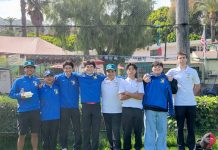An icon. A sector of memory. The center of communities. These are not typically concepts that are associated with a boat, but Moomat Ahiko is no ordinary vessel.
As part of Catalina Island Conservancy’s Last Friday Lecture Series, Cindi Alvitre, professor at California State University Long Beach and co-founder of the Ti’at Society, told the story of Moomat Ahiko on California Indian Day.
As a California Indian scholar who considers herself a facilitator as opposed to an authority, Alvitre gave a brief background of indigenous life on the Channel Islands and spoke about the history of ti’aatem (traditional sewn plank canoes) brought to life by the Ti’at Society in the 1980s.
“If you really want to know what’s going on, you ask the people,” said Alvitre, who referenced philosopher Pierre Nora’s concept of lieu de mémoire (places of memory). “His study and philosophy says that memory is in the present. Such places of memory become the basis for social identity, constantly negotiated in the world.”
She said that this concept is very familiar to Tongva people. Though indigenous descendants may drive on the 405, but “to us, we see below the asphalt. We know our sacred sites. We know where the land is. We know the sacredness of everything: The water, the earth, the air, the animals.”
Sewn plank canoes have been a staple of life in the Channel Islands for hundreds – if not thousands – of years, with Juan Rodríguez Cabrillo observing plank canoes holding eight to ten indigenous people off Pimu (Catalina Island) in 1542.
“This is a tradition that became almost completely extinct after colonization,” she said.
Ethnologist John Peabody Harrington spoke to a Chumash man, Kitsepawit (Fernando Librado) who instructed researchers in how to build these canoes in the early 1900s. In the 1980s, Moomat Ahiko was “born in the dreamtime.”
Tired single mother Alvitre had a dream one night. In this vision, she could hear her kids laughing and playing, and saw them joyfully tossing balls of lava to each other. She saw the Santa Ana mountains with a warrior embedded in them. He had his hair pulled back in a traditional hair pin with lava pouring out between his closed eyes. Her next dream went deeper with the addition of a large lake of water in front of the mountains. Large wooden boats were in the water, populated by her father, cousins and community. Everyone started to sing in synchronicity and as the warrior opened is eyes, the mountains parted and people began to paddle to Pimu.
“Those mountains are powerful,” she said. “They speak.”
Two weeks after her dream, Jim Noyes from the California Indigenous Maritime Association called asking if she would help build a traditional ti’at. And thus Moomat Ahiko was brought to life.
“It brought our communities together,” she said. “We’ve continued. We’ve restored her and worked on her over the years.”
“Nobody will disrespect her,” Alvitre added, of the vessel that was featured during the 1996 Ti’at Festival on Catalina Island and in a KCET documentary.
Through her presentation, Alvitre emphasized the importance of acknowledgement of indigenous people and the willingness to ask questions.
“We have to honor and embrace that which sustains us: The earth, the water, the wind, the fire. This gives us all life. It is undeniable,” she said. “When you have recognition and respect, then perhaps we can be responsible in our actions.”











